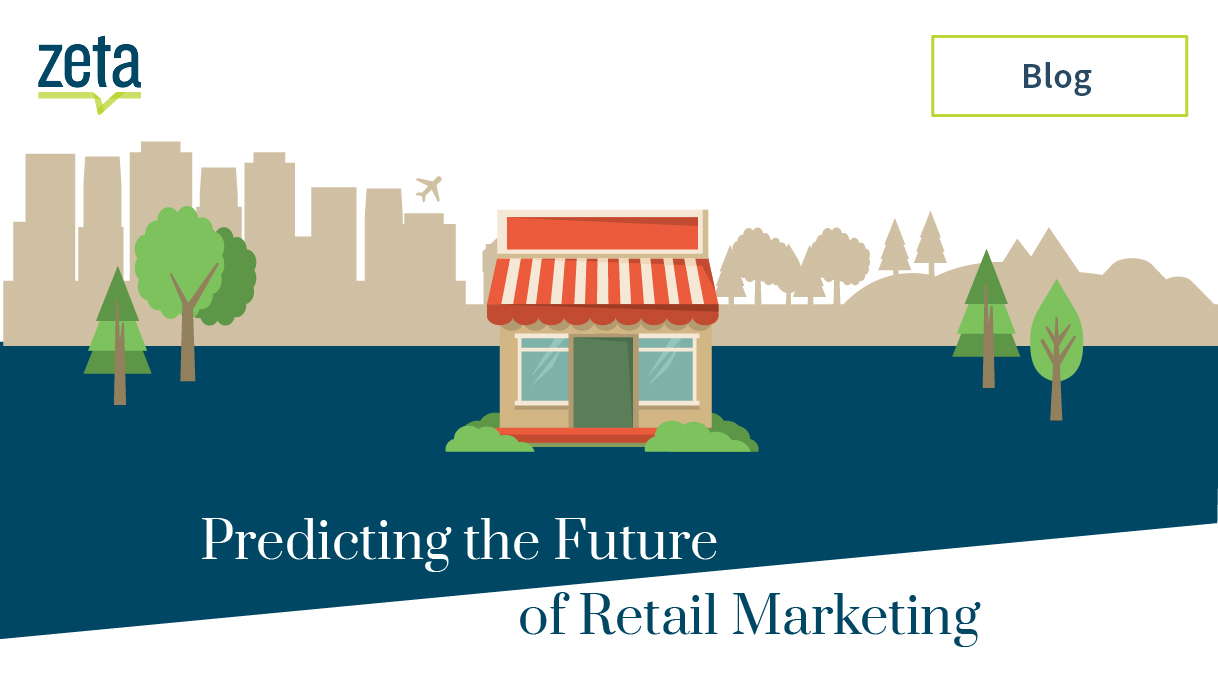
Articles | July 31, 2020 | 3 min read
Predicting the Future of Retail Marketing
The massive impact COVID-19 is having on the retail industry can’t be understated—and it’s why predicting the future of retail marketing is so important.
New data suggests:
To survive, retail brands (be they ecommerce, DTC, or traditional brick-and-mortar) will need to make sweeping changes to meet the evolving expectations of consumers.
At Zeta, we believe the following changes are worth preparing for ASAP.
High unemployment (up 420% since February 2020) numbers are forcing millions of American consumers to pause on discretionary retail spending, in favor of meeting immediate needs (e.g. rent, groceries, utilities, etc.).
The current hesitancy towards discretionary retail will be exacerbated in the months ahead by two things:
Number one? The sustained presence of the coronavirus.
Number two? The paring down of existing federal stimulus programs (the latest Congressional signals indicate federal unemployment stimulus will drop from $600 per week to $200.)
These two factors will fuel a lackluster economic recovery (things are starting to look less like a “V”) and keep consumers hunkered down at home, sitting on whatever discretionary cash they can save until at least Q1 2021.
When it comes to predicting the future of retail marketing, this is perhaps the easiest projection to make.
Consumers will be more price sensitive than brand loyal in the months ahead, and that’s going to be the norm for some time.
In other words, great deals and lucrative offers will be the catalyst for driving sales for the rest of 2020—especially on big-ticket items.
The notion of “personalization” is nothing new to retail. From promotions to shopping experiences, brands know how much consumers value curated engagement (it’s the lifeblood behind DTC brands like Stitch Fix and BirchBox). But just because they know about personalization, doesn’t mean they’ve been pursuing it.
That changes now.
With consumers pulling back on discretionary retail spending for the rest of the year, brands will need to do everything they can to take their share of a shrinking “dollar-pie.” That means getting serious about the power of personalization.
(Remember, 59% of pre-pandemic consumers felt personalization played a major role in shaping their buying decisions—a number that’s undoubtedly grown in the past several months.)
To do it, retailers must get more out of their first-party data. They need to invest in platforms and technologies that give them access to real-time behavioral, transactional, and location signals. Using such third-party signals in conjunction with first-party data (e.g. known email addresses, loyalty program numbers, etc.) will make it easier to develop marketing initiatives personalized to the expectations of an individual consumer.
Naturally, better personalization requires better data. So, when it comes to predicting the future of retail marketing, suffice to say the collection and analysis of consumer data will become even more important than it already is. That means investing in platforms, solutions, and data management resources that make it easier to:
The more detailed the data and intent signals, the more successful retailers will be in stocking the products and pushing the promotions that are of greatest interest to cautious shoppers.
The retail industry won’t return to a state of “normalcy” until a COVID-19 vaccine emerges and the broader global economy starts to recover. Realistically, these two things won’t occur until the Spring of 2021 at the earliest.
Having said that, truly preparing for the future means preparing for when things open back up. Therefore, this article can’t conclude without reminding retailers about the importance of creating memorable, in-person experiences in the future. The kind of experiences that allow a brand to position itself as unique amongst its peers with a clear, identifiable value proposition.
For brick-and-mortar retailers, this will mean laying out stores in ways that optimize social distancing, while simultaneously emphasizing the placement of marquee products to maximize the overall customer experience.
The COVID-19 recession is bringing BIG change to retail. It’s forcing the industry to say “goodbye” to famous names like Brooks Brothers and Neiman Marcus. Similarly, it’s forcing some of the industry’s biggest brands, including Walmart and Target, to rethink the way they do business.
But the good news is retail will survive—even if it doesn’t feel like it right now. For forward-thinking retailers looking to embrace even more granular data to provide improved customer experiences and make smarter marketing decisions, Zeta will be there to help every step of the way.
New data suggests:
- Global retail sales will decline by an average of 9.6% this year, a $2.1 trillion loss from 2019.
- US retail sales will decline by an average of 9.1% this year, a $321 billion loss from 2019.
- Foot traffic to big box retailers (e.g. Target) is down 25.2%.
- Foot traffic to popular department stores (e.g. Macy’s) is down 91.5%.
- Foot traffic to specialty retail locations (e.g. Williams Sonoma) is down almost 70%.
To survive, retail brands (be they ecommerce, DTC, or traditional brick-and-mortar) will need to make sweeping changes to meet the evolving expectations of consumers.
At Zeta, we believe the following changes are worth preparing for ASAP.
The “carefree consumer” will be in hibernation for a while
High unemployment (up 420% since February 2020) numbers are forcing millions of American consumers to pause on discretionary retail spending, in favor of meeting immediate needs (e.g. rent, groceries, utilities, etc.).
The current hesitancy towards discretionary retail will be exacerbated in the months ahead by two things:
Number one? The sustained presence of the coronavirus.
Number two? The paring down of existing federal stimulus programs (the latest Congressional signals indicate federal unemployment stimulus will drop from $600 per week to $200.)
These two factors will fuel a lackluster economic recovery (things are starting to look less like a “V”) and keep consumers hunkered down at home, sitting on whatever discretionary cash they can save until at least Q1 2021.
Price-sensitive shoppers will become the norm
When it comes to predicting the future of retail marketing, this is perhaps the easiest projection to make.
Consumers will be more price sensitive than brand loyal in the months ahead, and that’s going to be the norm for some time.
In other words, great deals and lucrative offers will be the catalyst for driving sales for the rest of 2020—especially on big-ticket items.
Personalization will become even more important
The notion of “personalization” is nothing new to retail. From promotions to shopping experiences, brands know how much consumers value curated engagement (it’s the lifeblood behind DTC brands like Stitch Fix and BirchBox). But just because they know about personalization, doesn’t mean they’ve been pursuing it.
That changes now.
With consumers pulling back on discretionary retail spending for the rest of the year, brands will need to do everything they can to take their share of a shrinking “dollar-pie.” That means getting serious about the power of personalization.
(Remember, 59% of pre-pandemic consumers felt personalization played a major role in shaping their buying decisions—a number that’s undoubtedly grown in the past several months.)
To do it, retailers must get more out of their first-party data. They need to invest in platforms and technologies that give them access to real-time behavioral, transactional, and location signals. Using such third-party signals in conjunction with first-party data (e.g. known email addresses, loyalty program numbers, etc.) will make it easier to develop marketing initiatives personalized to the expectations of an individual consumer.
Drilling down into data will be non-negotiable
Naturally, better personalization requires better data. So, when it comes to predicting the future of retail marketing, suffice to say the collection and analysis of consumer data will become even more important than it already is. That means investing in platforms, solutions, and data management resources that make it easier to:
- Understand consumer needs
- Create compelling marketing materials
- Activate a wide array of paid and owned channels
The more detailed the data and intent signals, the more successful retailers will be in stocking the products and pushing the promotions that are of greatest interest to cautious shoppers.
Preparing for the inevitable return of normalcy
The retail industry won’t return to a state of “normalcy” until a COVID-19 vaccine emerges and the broader global economy starts to recover. Realistically, these two things won’t occur until the Spring of 2021 at the earliest.
Having said that, truly preparing for the future means preparing for when things open back up. Therefore, this article can’t conclude without reminding retailers about the importance of creating memorable, in-person experiences in the future. The kind of experiences that allow a brand to position itself as unique amongst its peers with a clear, identifiable value proposition.
For brick-and-mortar retailers, this will mean laying out stores in ways that optimize social distancing, while simultaneously emphasizing the placement of marquee products to maximize the overall customer experience.
Predicting the future of retail marketing with Zeta
The COVID-19 recession is bringing BIG change to retail. It’s forcing the industry to say “goodbye” to famous names like Brooks Brothers and Neiman Marcus. Similarly, it’s forcing some of the industry’s biggest brands, including Walmart and Target, to rethink the way they do business.
But the good news is retail will survive—even if it doesn’t feel like it right now. For forward-thinking retailers looking to embrace even more granular data to provide improved customer experiences and make smarter marketing decisions, Zeta will be there to help every step of the way.


